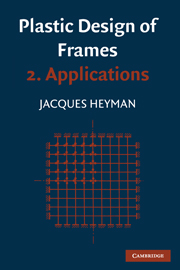4 - REINFORCED CONCRETE AND MASONRY
Published online by Cambridge University Press: 05 November 2011
Summary
If a simply-supported reinforced-concrete beam is tested to collapse, the load–deflexion curve exhibits many of the characteristics associated with the results of a test on a corresponding mild steel beam. Under normal circumstances, for example, the behaviour of the concrete beam is not brittle; yielding of the steel reinforcement will permit large deflexions, and a more or less definite plastic hinge may be observed. At very large deflexions the concrete starts to crush, and the resisting moment at the plastic hinge will fall; the length of the ‘plateau’, corresponding to a notional full plastic moment, and the rate of fall-off of bending moment at large hinge rotations, are functions of the amount and disposition of the reinforcement.
This ‘drooping characteristic’ of reinforced concrete renders strictly invalid all the theorems of simple plastic theory which are such powerful tools in the analysis of ductile structures. In a practical sense, however, the application of simple plastic theory to reinforced-concrete design will lead to perfectly satisfactory structures; or, at worst, it will lead to designs which can be examined carefully in the light of any other criteria the designer may choose to use. As was noticed on the closing page of vol. 1, a plastic estimate of structural behaviour can be used with at least as much confidence as a conventional elastic estimate.
- Type
- Chapter
- Information
- Plastic Design of Frames , pp. 60 - 87Publisher: Cambridge University PressPrint publication year: 1971



